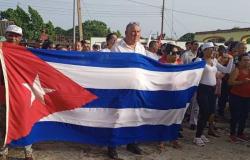
Two decades ago, a process that had begun in 1980 ended when the Maori communities began a claim to recover collectibles and human remains that, as a result of looting, had reached Europe and America during the 19th and 20th centuries. It was in 2004 when the Juan Bautista Ambrosetti Ethnographic Museum, dependent on the Faculty of Philosophy and Letters of the University of Buenos Aires (UBA), returned – on his own initiative – to New Zealand, a toi moko, a mummified and tattooed head that belonged to a Maori warrior.
The head was brought in 2004 from Argentina to the National Museum of New Zealand Te Papa Tongarewa. The toi moko, which had entered the collections of the Ethnographic Museum in 1910, was received two decades ago with a solemn funeral ceremony by senior members of the Maori community and directors of Te Papa Tongarewa. The person in charge of taking it to New Zealand was the renowned archaeologist José Antonio Pérez Gollán, whom everyone called “Pepe Pérez” and was in charge of the Ethnographic Museum. In journalistic reports from 2004 – there were both in Argentina and New Zealand – Pérez Gollán had said that: “They placed the head that I carried on a platform, covered with a blanket of kiwi feathers. They held a funeral and sang in their language. “They welcomed me like a friend.”
Pérez Gollán, who died in 2014, wrote an article about that restitution together with Andrea Pegoraro, who is the current director of the Ethnographic Museum. In the article published in 2004 in the magazine Relationships, of the Argentine Society of Anthropology, it is explained that: “The antecedents of the return date back to the beginning of 2003 when, on the occasion of the visit to the Ethnographic Museum of Mr. Carl Worker, Ambassador of New Zealand in Argentina, we expressed our desire for the mummified head to return to the hands of the Maori people. The formal procedures began on April 8, 2003 with a note that was delivered to the New Zealand embassy, requesting the opening of the official procedure for repatriation. A year later, some of us were invited to travel carrying the toi moko to leave it in the hands of the Te Papa Tongarewa team that is responsible for reclaiming Maori human remains found outside of New Zealand.”
The Maori arrived in New Zealand a little over a thousand years ago. Their tattoo culture was discovered by Europeans in 1769, when the English explorer James Cook arrived in Tahiti and also explored the New Zealand coast. It was then that the naturalist Joseph Banks reported the first description of a toi moko, as the Maori facial tattoo is called. Engraved on the skin with a very painful technique, the “tatú” – as the English thought they heard – was shared by the people of Polynesia, who spread it all over the body. But The Maori, a warrior people, limited it to the face, and only to men. With spirals and subtly different designs, the toi moko became the hallmark of each individual, as they reflected each person’s lineage and the social hierarchy in which they were inserted. When a chief died, his head was embalmed and passed down from generation to generation. But also The toi moko of the enemy killed in combat was kept to insult him. These heads became objects of interest for European collectors and museums from the 18th century onwards, fueling a trade that led to abuse and falsifications. The greed of scientific entities and collectors meant that, to sell the toi moko, the Maori sacrificed their low-ranking peers and tattooed them post-mortem. This led to the British colonial government passing a law in 1831 prohibiting its trafficking, although the practices continued for some time.
In 1905 the Faculty of Philosophy and Letters had founded the Ethnographic Museum to promote the teaching and dissemination of American prehistory and ethnography. It also had to fulfill the functions of a university research and training institute. But it was also to become a center for the education of the general public. Juan Bautista Ambrosetti was appointed director in recognition of the activity he had carried out to promote the creation of the museum and, also, for his background as a researcher and professor: at that time he was already a substitute professor of American Archeology at the Faculty of Philosophy and Letters of the UBA.
In that article published 20 years ago Gollán and Pegoraro referred to William Oldman, a prominent merchant who offered to sell ethnographic specimens from Oceania and North America through illustrated catalogues. The authors explained how the mummified and tattooed head arrived at the Ethnographic Museum: “In 1910, one of Oldman’s catalogs came into Ambrosetti’s hands with a list of pieces, their price and, in some cases, a brief description and drawing. But we suppose that it was nothing short of illusory to think about entering the English art market, when the austere budget of the Ethnographic Museum was almost entirely allocated to covering the expenses of archaeological expeditions. Faced with a situation like this, the only possibility that arose was to turn to someone with financial solvency and interested in promoting knowledge and culture. The person who met all these conditions was Don Antonio Devoto, an Italian businessman who had fields in the pampas and exported frozen meats from the Argentine Refrigerator that he owned. Ambrosetti approached him to ‘request his patriotic help in pursuit of a university institution of high culture’, asking him to buy a lot of pieces from Oceania that Oldman offered; In exchange, he proposed that the collection bear his name. Devoto accepted the order and offered to make the purchase when he traveled to Europe. The set, which was made up of 278 objects from Polynesia and Australasia, began to be exhibited with a bronze plaque that identified it as the Antonio Devoto Collection during the sessions of the XVII International Congress of Americanists. It was visited with great interest by the general public, researchers and journalists: the magazine Caras y Caretas, to cite one case, dedicated an article profusely illustrated with photographs to it.” And they added that: ”The mummified head was invented in the Ethnographic Museum under number 11961, with the transcription of the legend from Oldman’s catalogue: ‘preserved head of a Maori chief, beautiful Moko tattoo, these heads are now extremely rare.’ Ear ornament made with a tiger shark tooth that has red wax attached. A part of the skull has been shaved. It is accompanied by a sketch of the Moko. New Zealand”.
The repatriation of the toi moko that was in Argentina is part of a global movement to restitute human remains to their original communities. In recent decades, representatives of indigenous peoples have demanded the return of the bodies of their ancestors, which are found in scientific collections in museums around the world. In New Zealand, Te Papa Tongarewa has led these initiatives, and between 1985 and 2023 he achieved the repatriation of some 850 Māori remains, including several toi moko. These remains arrived from England, Germany, the United States, Wales, Scotland and Australia among other countries. When Pérez Gollán returned the toi moko 20 years ago he had said: “I cannot consider a toi moko as a museum object: it is someone’s ancestor. I do not exhibit remains but heritage, and a form of interpretation of the past.”





